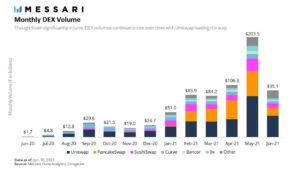
SPONSORED POST*
In only a few days, 2023 witnessed the greatest development in blockchain technology. First, we had Snowfall Protocol (SNW), a cross-chain bridging solution, launched its dApp and DEX prototype, and it is nothing but an innovative next-gen beauty. The interchain bridging solution has seen exceptional demand from investors, and the buzz is nothing we’ve seen before.
Fantom plans to expand its dApp to serve its users better, and Polygon is making key upgrades this month. Read on to learn more about the recent notable development in blockchain technology in 2023.

Snowfall Protocol’s dApp and DEX Prototype Met With Great Enthusiasm
The release of Snowfall Protocol’s dApp and DEX prototype has further boosted its demand. Investors see the protocol as a great opportunity to close the technical gap between more than 200 blockchain networks. Investors are pleased to witness the emergence of a first-of-its-kind bridging solution, which means only one thing: more demand and value.
Snowfall Protocol’s dApp and DEX prototype were designed with one main objective: to bring different blockchain networks together and enhance secure asset transfer. This will further enhance cross-chain communication, interoperability, and flexibility.
Snowfall Protocol is the first multi-chain bridge for crypto assets and NFTs. It is quickly gaining traction because of its innovative approach to securely bridging assets with its canonical/reverse canonical token bridges for fungible tokens. There is also a swap and wrap system for NFTs.
As blockchain grows, The use case of Snowfall Protocol (SNW) will become increasingly indispensable. Meanwhile, anyone can invest in the protocol’s native token, $SNW, at this early stage. The token is trading at $0.191, and experts think it would easily reach 500x to 1000x. With its use cases and application, the exponential growth of $SNW is indisputable.
Fantom To Expand dApp Ecosystem
Fantom network, a layer one scalable and open-source blockchain protocol, is not left out in the revolutionary changes aimed at enhancing blockchain technology’s scalability and usability. In a recent announcement, Andre Cronje, the lead architect and co-founder of the network, revealed Fantom’s plan to expand its dApp ecosystem.
The overarching objectives of Fantom will focus on improving the protocol’s scalability and promoting sustainability for developers and users. As part of Cronje’s plan, there will be gas monetization and gas reforms to improve Fantom’s revenue and incentive development. As part of the gas reform policies, anyone using the Fantom network can start a transaction and pay for gas fees directly.
The new policies will level the playing ground for smart contracts and externally held accounts. Meanwhile, Fantom users will also be able to pay gas fees with other tokens. As part of the expansion, Cronje has also made it known that the Fantom Virtual Machine will be the new center of attraction for Fantom. Since the announcement, FTM has gained more than 60% and is now trading at $0.32.
Polygon Map Out Key Hard Fork Plans
Polygon is a layer two solution on the Ethereum blockchain, and it was created to solve the blockchain trilemma and improve scalability. However, like Ethereum, Polygon is not immune to network gas spikes.
However, in recent updates, Polygon has revealed its plans to implement major upgrades in its ecosystem. The upgrade primarily involves a hard fork to reduce unprecedented gas spikes and address reorgs (chain reorganizations).
It’s no doubt that Polygon is one of the most used layer-two solutions and, therefore, experienced a spike in activity. The hard fork will double the “BaseFeeChangeDenominator” to maintain baseFee when there are fluctuations in gas limit in a block.

Conclusion
You can also be a part of this life-changing opportunity – sign up and buy $SNW at Snowfall Protocol’s presale website.
Presale: https://presale.snowfallprotocol.io
Website: https://snowfallprotocol.io
Telegram: https://t.me/snowfallcoin
Twitter: https://twitter.com/snowfallcoin
*This article was paid for. The Cryptonomist did not write the article or test the platform.






















